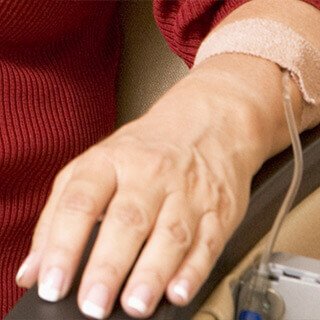IV Access Care During Chemo
 Women who have intravenous chemotherapy as a part of their treatment plan find having a semi-permanent IV catheter surgically implanted is a safe and comfortable option. Chemotherapy is given over months with breaks in between treatments to allow the body time to regenerate blood cells. Patients are exposed to multiple needle sticks to draw blood specimens for tests and to administer medication. The veins in the hands and arms eventually become tough and scarred as well as diminished. To preserve the smaller peripheral veins, Oncologists recommend implantation of a central intravenous devise that can be used for drawing blood samples as well as a reliable conduit for delivering the chemotherapeutic medication.
Women who have intravenous chemotherapy as a part of their treatment plan find having a semi-permanent IV catheter surgically implanted is a safe and comfortable option. Chemotherapy is given over months with breaks in between treatments to allow the body time to regenerate blood cells. Patients are exposed to multiple needle sticks to draw blood specimens for tests and to administer medication. The veins in the hands and arms eventually become tough and scarred as well as diminished. To preserve the smaller peripheral veins, Oncologists recommend implantation of a central intravenous devise that can be used for drawing blood samples as well as a reliable conduit for delivering the chemotherapeutic medication.
Another reason for choosing a larger central vein is that the larger the diameter of the blood vessel, the more blood volume is present to dilute the medication. Some chemotherapy medications are caustic to the blood vessels and can cause great tissue damage should they leak through a smaller blood vessel. For this reason, the subclavian vein is used to thread the implanted IV catheter (plastic tube). This vein is located under the collar bone and runs into the vena cava, the largest vein in the body.
"To preserve the smaller peripheral veins, Oncologists recommend implantation of a central intravenous devise that can be used for drawing blood samples as well as a reliable conduit for delivering the chemotherapeutic medication."
Most physicians recommend a system that is completely enclosed within the skin called a port-a-catheter. The port is accessed by a special type of needle and is only used to administer medication or draw blood samples. No tubes or dressings are necessary after the port is used and flushed. The infection rate is very low for this type of device.
An outpatient surgical procedure is usually performed to place the port. It usually takes about one hour for the procedure. An xray is done after the procedure to verify placement of the device. The patient will feel a small bump under the skin where the port is placed.
Complications are rare with this type of device. During implantation, there is a 1% to 2% occurrence of puncturing the patient's lung. This is usually requires a day or two of hospital observation. Other complications include infection and clotting of the device. Both of these conditions are treatable. The port requires monthly flushing when not in use. After the chemotherapy treatment program has been completed, the port can be removed.







